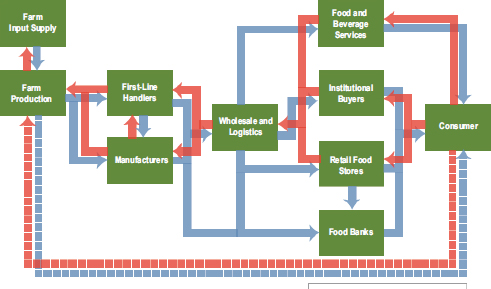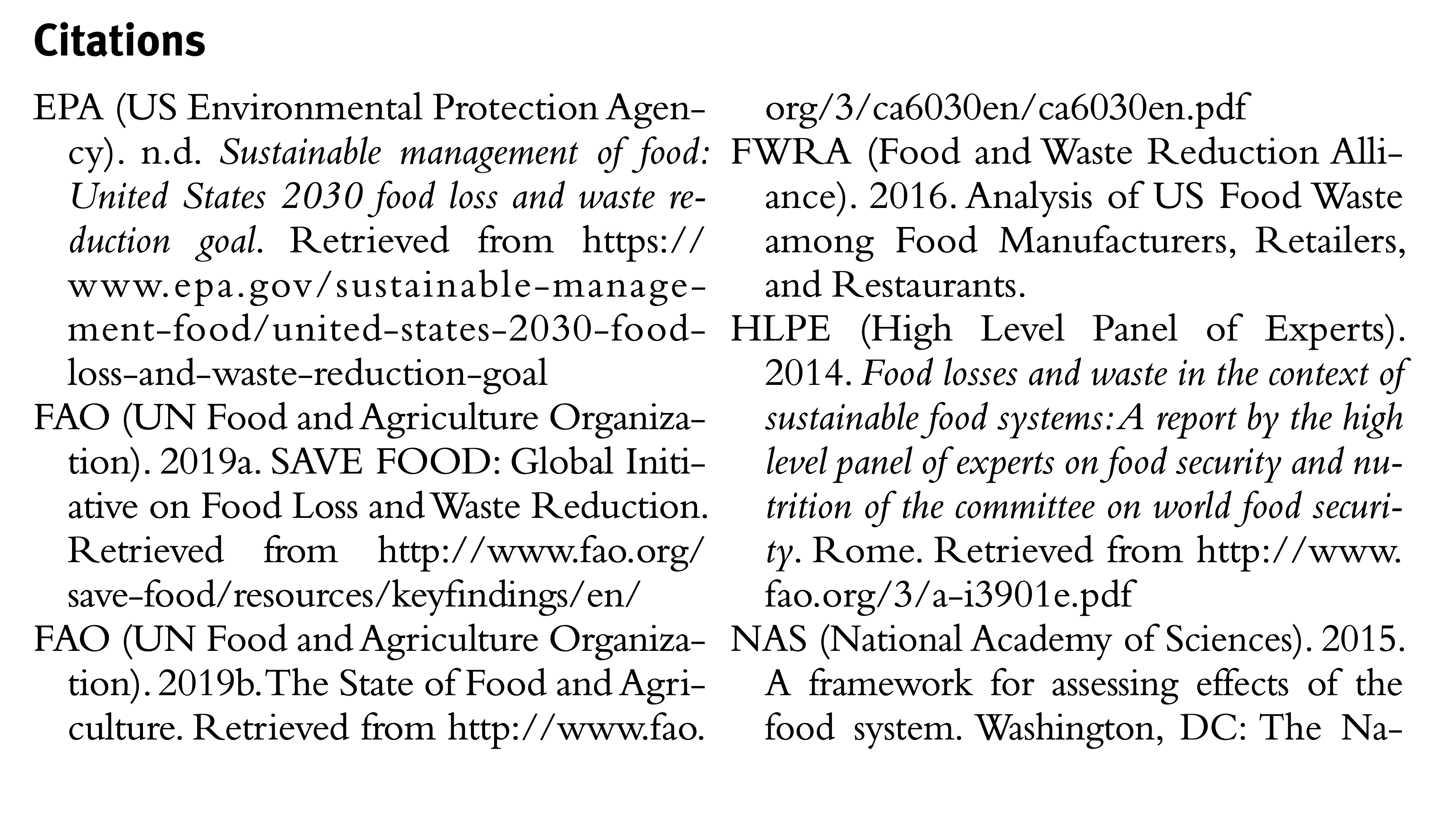Increasing Food System Efficiencies through Coordinated Innovative and Sustainable Food Loss and Waste Reduction Strategies
Chapter From
The Proceedings of the Workshop on"Reduction of Food Loss and Waste"Vatican City, 2020Scripta Varia 147ISBN 978-88-7761-115-4
Edited by
Joachim von Braun, Marcelo Sánchez Sorondo & Roy SteinerIn partnership between the Pontifical Academy of Sciences and the Rockefeller FoundationBy: Lucyna Kurtyka
The author is Senior Scientific Program Director at the Foundation for Food and Agriculture Research (FFAR) – a nonprofit organization established by US Congress in the Agricultural Act of 2014 known as the Farm Bill.Co-chair of the Consortium Advisory Council
Introduction
According to the United Nations’ Food and Agriculture Organization (FAO), one-third of all food produced for human consumption in the world is lost or wasted, which amounts to $990 billion per year (FAO, 2019a). Food loss occurs along the food supply chain from in-field up to retail. Food waste occurs at the retail and consumption levels (FAO, 2019b).
The amount of available and wasted food varies by country. In the United States, up to 40% of food is thrown away, costing Americans $218 billion/year (NRDC, 2017), and nearly 85% of waste occurs at consum- er-facing businesses (supermarkets, grocery stores, restaurants, cafeterias, etc.) and homes (ReFED, 2016). Food waste is the largest component of landfills, which are the third largest source of methane (USDA, 2015). According to a study by Spiker et al. (2017), in 2012 the amount of food discarded in the United States at the retail and consumer levels alone could have provided 2,000 kcal/day to 84% of the US adult population. The authors analyzed the loss of vitamins A and E, calcium, magnesium, iron, and fiber. They estimated that, for example, the amount of wasted dietary fiber could have filled the gap of underconsumed dietary fiber (i.e., the difference between the Recommended Dietary Allowance and the actual intake) for 206.6 million adult women. The authors also recognized that only a portion of this nutritional value could be recovered for human consumption.
In addition to loss of nutrients, food losses and waste represent a waste of valuable resources used in production such as land, water, energy, agricultural chemicals and labor, which puts significant strains on the environment, economy, and society.According to the High-Level Panel of Experts (HLPE) on Food Security and Nutrition of the Committee onWorld Food Security, the extent of food loss and waste (FLAW) means that it should be consid- ered not an accident, but an entrenched component of food systems. FLAW is the consequence of the way food systems function technically, culturally, and economically (HLPE, 2014). The prevention of FLAW not only can save food itself, but can also lead to economic, environmental and social benefits, while contributing to food security and helping mitigate climate change.
FLAW has been gaining worldwide attention from governments, food manufacturers, retailers, and nonprofit organizations. Numerous policies, strategies, and practices have been developed and applied across the globe to reduce food waste and redirect surplus food to improve food security, reduce food costs and benefit the environment. In September 2015 the United Nations (UN) General Assembly adopted a set of 17 Sustainable Development Goals. Goal 12 seeks to “ensure sustainable consumption and production patterns." The third target under this goal (Target 12.3) calls on all nations to “halve per capita global food waste at the retail and consumer levels and reduce food losses along production and sup- ply chains, including post-harvest losses” by 2030 (UN, n.d.) The same month the UN Sustainable Goals were adopted, the US government set the first ever national goal for food waste reduction at 50% by 2030. This effort, led by the US Department of Agriculture (USDA) and the US Environmental Protection Agency (EPA), seeks to work with com- munities, organizations and businesses along with state, tribal and local governments (USDA, 2015; EPA, n.d.).
Challenges and research opportunities
The food system is global, highly complex and constantly evolving. It involves interactions among humans, resources, and environments that are part of food production, storage, distribution, and disposal (Figure 1). However, the food production system also generates by-products and food waste. Changes made to one element of that system may intentionally or unintentionally impact others. The food system faces numerous challenges, such as climate change and loss of arable land, changes in dietary preferences and consumer attitudes toward food production, and new delivery systems. Systems approaches are needed to better understand and evaluate these interactions and to develop effective and sustainable innovations (both technological and non-technological) aimed at increasing the availability of nutritious food while reducing FLAW.

Reducing FLAW should be a priority in establishing more sustainable patterns of food production and consumption. It is imperative to increase efficiencies in agricultural and food production not only to address food supply needs associated with an increasing global population, but also to address increasing nutrient and fiber demands. Achieving these goals will require a forward-looking, holistic and transformative approach to the food system that integrates different perspectives, including those outside the traditional food and agriculture groups.
Because the FLAW problem is such a multifaceted complex issue, it is often challenging to define top priorities for research or interventions. So far, approach to FLAW has been fragmented. Multiple entities work to address this issue, each focusing on a different segment of the food system. Often, this work is not coordinated with other groups.
Science plays a prominent role in building and transforming the world, and its role cannot be overstated in tackling FLAW. It allows not only the development of a robust knowledge base, but also the pursuit of techno- logical and non-technological solutions. Science provides an indisputable and objective basis for developing creative policies and mechanisms to foster innovation and enable entrepreneurship. Scientific partnerships bring together diverse groups representing different disciplines and perspectives across the food system, allowing them to develop and work toward common goals while sharing resources and responsibilities. Science ensures a holistic approach to the issue.
Overall, groundbreaking research is needed on sustainable FLAW reduction to decrease negative environmental impacts of that loss and waste, and forge greater food security. Questions to be considered when organizing research on FLAW include:
– Which challenges could be addressed by research? Are there proof-of- concept projects that could be conducted to help scale up promising approaches to reducing the generation of wasted food?
– Which challenges should be tackled first?
– Which research projects would have the greatest impact on reducing food waste through prevention and food rescue? In other words, what is a game changer?
– What stakeholders would need to be involved in scoping or implementing research?
– What research questions are not being answered and why?
– What research questions are being answered within different disciplines or contexts that could be applicable to addressing FLAW?
– How can we better frame and scope research to answer questions that drive action?
– What are the different ways that we could categorize research to identify gaps, commonalities, and opportunities?
– What stakeholders would need to be involved in scoping or implementing the research?
– How to measure success?
When developing a research agenda aimed at reducing FLAW, socio-economic factors must also be taken into consideration. Economic status, food preferences, habits, emotions, and interpersonal interactions are among fac tors that contribute to food waste generation in homes. Another factor in discarding safe food is confusion around food labeling, such as “best by” date. Retail can waste high volumes of food that is safe and edible because products do not meet customer demands around variety, consistency and freshness, or because the product was overstocked, no longer meets appearance standards or has damaged packaging. In the case of restaurants, the type and amount of generated food waste depends on the restaurant model. An example is a quick-service restaurant where food is less commonly consumed on the premises compared to full-service restaurants. Unlike retailers, the biggest issue for restaurants is that most discarded food consists in consumer ‘leftovers’, which, for safety reasons, are no longer consumable (FWRA, 2016).
Recognizing the importance of different stakeholders working together to address challenges faced by the food system, in 2014 the US Congress established the Foundation for Food and Agriculture Research (FFAR; www.foundationfar.org) in the Agricultural Act known as the Farm Bill. FFAR was created to support food and agriculture research, foster collaboration, and advance and complement the mission of the US Department of Agriculture. The premise of FFAR’s formation was that increased investment in cutting edge research and development, through public-private partnerships, would be critical to nourishing a growing global population.
That is why in 2019 FFAR, together with the Rockefeller Foundation, co-funded the Consortium for Innovation in Post-harvest Loss and Food Waste Reduction where thought leaders and experts from across the globe work together with industry and nonprofit organizations to address social, economic and environmental impacts from FLAW. Participating institutions include Iowa State University, USA; University of Maryland, USA; Wageningen University and Research, Netherlands; Zamorano University, Honduras; University of São Paulo, Brazil; Stellenbosch University, South Africa; University of Nairobi, Kenya; Kwame Nkrumah University of Science and Technology, Ghana; and the Volcani Center, Israel. The Consortium works collaboratively to develop a scalable approach for adoption of the Rockefeller Foundation’sYieldWise model to provide farmers in developing and developed countries with cost-effective strategies and technologies that link their crop supply to market demand. This will allow farmers to gain more value from their crops and become more profitable, while stimulating local economic growth and improving the resiliency of rural communities. In addition to developing strategies to reduce FLAW, the Consortium is building the academic and entrepreneurial capacity of the next generation of scientists by engaging researches and students in multi-national multi-disciplinary teams in the project identification, planning and execution phases together with professionals from the private and public sectors.
Food waste is often interconnected with packaging waste, yet both issues are often viewed as at odds with one another.The core purpose of packaging is to protect and extend the life of food, making sure it arrives fresh and intact to store shelves and our homes. At the same time, packaging, particularly plastic packaging, has been receiving increased attention from food businesses, nonprofit organizations, policymakers and consumers due to end-of-life waste management concerns. The Foundation for Food and Agriculture Research is spearheading a Food Packaging Prize to identify and accelerate the most promising packaging solutions related to food waste. Expected outcomes from this initiative include:
– Innovative food packaging materials and/or technologies that replace currently used packaging (polystyrene foam trays, plastic clamshells, freezer wrap, etc.) and meet the highest sustainability, food safety, and food quality criteria adopted and integrated into the food value chain.
– Increased collective knowledge around optimizing the intersection between food waste reduction and packaging material sustainability to reduce costs and environmental impacts across the food system.
The Prize will also foster competition and build momentum to support scientific breakthroughs, from concept to prototype development, to provide practical solutions for the food industry and retailers.
In summary, the number of improvements aimed at reducing FLAW or recovering food that otherwise would go to waste has been growing, but more is needed.Technical and non-technical innovations, innovative processing technologies, and online platforms are needed to help reduce food waste or divert it from landfills on a large scale from farm to the consumer. At the same time, to take full advantage of the benefits these innovations could offer and see their impact, they would have to be widely adopted across the food system.


